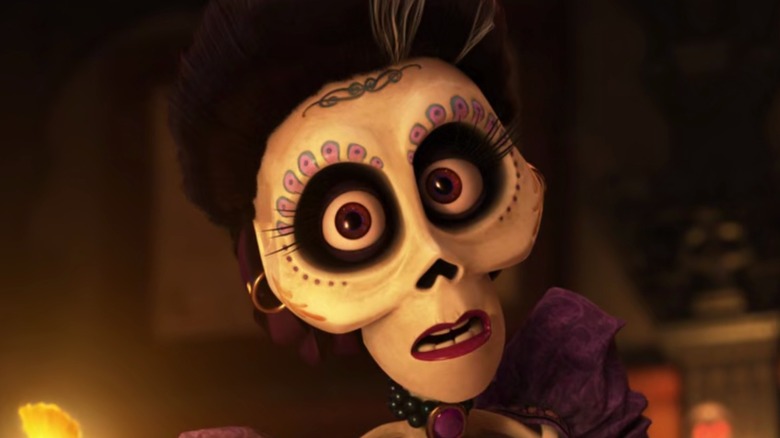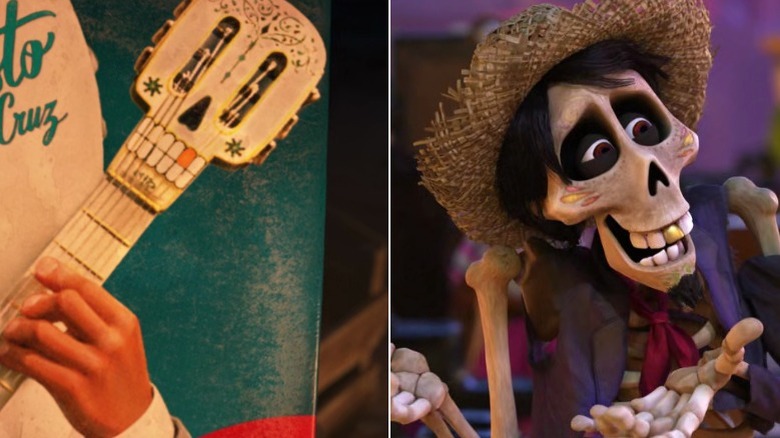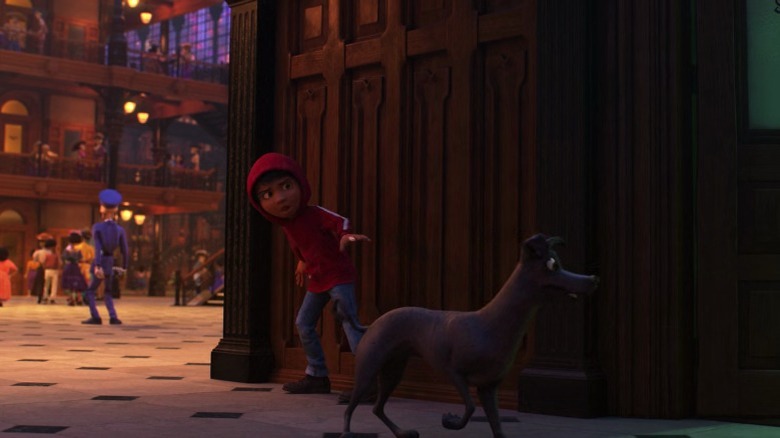The Big Clue Everyone Missed Early In Disney-Pixar's Coco
Warning: This article contains major spoilers for "Coco."
Lee Unkrich and Adrian Molina's "Coco" is well-reputed for the visual grandeur with which it renders the Land of the Dead, the delicacy and subtlety of its philosophical musings on familial remembrance, and the sheer irresistible, tear-jerking prowess of its final 15 minutes, which contain some of the most affecting filmmaking in all of Disney-Pixar history.
But a more underrated aspect of the smash-hit animated fantasy adventure is its narrative intricacy — especially when it comes to the seeds it plants along the way. Scripted by Molina and Matthew Aldrich from an original story by Unkrich, Aldrich, Molina, and Jason Katz (via IMDb), "Coco" is positively teeming with little hints and indications about where it's headed; if you were taken aback by the film's one-two punch of climatic twists the first time around, a second viewing might reveal just how much groundwork is laid for those reveals beforehand.
As a case in point, in the first 30 minutes alone the movie has already pretty much come out and told us twice the real identity of Miguel's great-great-grandfather.
The guitar has a gold tooth, just like Héctor
Miguel, the protagonist of "Coco," is a music lover and inveterate guitar player who almost literally worships at the altar of Ernesto de la Cruz, who the film proclaims is "the greatest musician of all time." While sequestered away in his attic hideout, Miguel watches Ernesto play guitar in old movies while plucking at the strings of his own worn-out guitar, which he has patterned after Ernesto's, complete with a grinning-skull headstock and a tooth painted gold. The revelation that Mamá Coco's estranged father owned that same guitar, as seen in her old family photo, is what convinces Miguel that he's Ernesto's great-great-grandson, and his attempt to "take back" the guitar from Ernesto's mausoleum is what sends him to the Land of the Dead.
The thing is, there's no real reason for Ernesto's headstock design to feature a gold tooth; like most superstar leading men, he has a set of shining, spotless pearly whites. But another character in Coco does have a gold tooth. Naturally, it's none other than Héctor, whose shiny incisor is conspicuous enough to blow his cover when he's trying to impersonate Frida Kahlo at customs. This similarity between Hector and the design of the iconic guitar all but spells out that he was its original owner. It's the first major tell that he is the real missing papá and that Ernesto stole his music to become famous.
Dante knows what's up
Along with the unveilings of Ernesto de la Cruz as a murderous villain and Héctor as Miguel's true ancestor, the ending of "Coco" brings another, equally important yet easy-to-overlook reveal. Miguel's dog Dante, who accompanies him to the Land of the Dead in a seeming flight of comedic fancy, turns out to be an alebrije, a spirit guide animal with the ability to transition freely between the two worlds.
This reveal, as well as the one about Héctor, are both foreshadowed very early on when Miguel is trying to evade his ancestors and the railway station authorities. As he and Dante attempt to walk through the station, Miguel exclaims, "We gotta find my great-great-grandpa!" Then they scramble to throw off a station officer, and when Miguel takes stock of his surroundings again, Dante is doing just as he's been told ... by following Héctor's scent to an interrogation room.
The information is right there, and yet, the scene happens so quickly that we don't even have time to think about why Dante's snout is leading him right to where Héctor is. As an alebrije, of course, Dante knows just what the trail of Miguel's ancestor should smell like. If only Miguel had paid attention to what his dog was trying to tell him then and there; it certainly could have spared him and Héctor a lot of running around.


